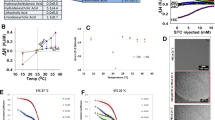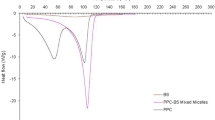Abstract
Purpose. The purpose of this study was to determine the distribution and diffusion of sodium taurocholate-phospholipid micelles with mucin in order to provide the foundation for understanding the transport of ingested fat and poorly water-soluble drugs through the intestinal mucous layer.
Methods. Sodium taurocholate (NaTC) was dispersed with egg phosphatidylcholines (PC) to yield mixed micelles of a specific size and concentration. A preliminary study was conducted to determine the time required for equilibration of PC/TC micellar solutions with mucin. PC/TC micellar solutions were dialyzed against fixed and variable concentrations of bovine submaxillary mucin after which the concentration of PC and NaTC was measured by an assay for total phosphorus and by HPLC, respectively. In addition, a quantitative assay of TC and PC by NMR was developed and used to estimate the mobile fraction of lipids in the samples. Finally, pulsed-field gradient spin echo NMR self-diffusion measurements were made of the water, TC, and PC in the samples obtained from dialysis.
Results. TC/PC micellar solutions achieved equilibrium with mucin in 7 days. Mucin did not affect the equilibrium concentration of PC or TC, except at high concentrations of mucin (5%), and then the effect was small. NMR quantitation was valid for PC and TC systems containing small micelles, but deviated significantly with systems containing large micelles. Mucin decreased the diffusivity of water and the phospholipids, but the effect was relatively small. Mucin dramatically affected the mobility of TC, which prevented a straightforward interpretation of the calculated diffusion coefficients.
Conclusions. Mucin has a minor effect on the equilibrium distribution of phospholipids and bile salts. However, lipids are readily accommodated by mucus, which can significantly increase the permeability of the mucous layer, particularly for poorly water-soluble drugs.
Similar content being viewed by others
REFERENCES
D. J. Cabral and D. M. Small. Physical chemistry of bile. In S. G. Schultz, J. G. Forte, and B. B. Rauner (eds.), Handbook of Physiology—The Gastrointestinal System III, Section 6, American Physiology Society, Waverly Press, New York, 1989, pp. 621-662.
V. L. Sallee, F. A. Wilson, and J. M. Dietschy. Determination of unidirectional uptake rates for lipids across the intestinal brush border. J. Lipid Res. 13:184-192 (1973).
H. Westergaard and J. M. Dietschy. The mechanism whereby bile acid micelles increase the rate of fatty acid and cholesterol uptake into the intestinal mucosal cell. J. Clin Invest. 58:97-108 (1976).
F. G. J. Poelma, R. Breas, J. J. Tukker, and D. J. A. Crommelin. Intestinal absorption of drugs. The influence of mixed micelles on the disappearance kinetics of drugs from the small intestine of the rat. J. Pharm. Pharmcol. 43:317-324 (1991).
L. M. Lichtenberger. The hydrophobic barrier properties of gastrointestinal mucus. Ann. Rev. Physiol. 65:565-583 (1995).
W. M. Saltzman, M. L. Radomsky, K. J. Whaley, and R. A. Cone. Antibody diffusion in human cervical mucus. Biophys. J. 66:508-518 (1994).
F. Nimmerfall and J. Rosenthaler. Significance of the goblet-cell mucin layer, the outermost luminal barrier to passage through the gut wall. Biochem. Biophys. Res. Comm. 94:960-966 (1980).
J.-J. Niibuchi, Y. Aramaki, and S. Tsuchiya. Binding of antibiotics to rat intestinal mucin. Int. J. Pharm. 30:181-187 (1986).
P. G. Bhat, D. R. Glanagan, and M. D. Donovan. Drug diffusion through cystic fibrotic mucus: Steady-state permeation, rheologic properties, and glycoprotein morphology. J. Pharm. Sci. 85:624-630 (1996).
B. F. Smith and J. T. LaMont. Hydrophobic binding properties of bovine gallbladder mucin. J. Biol. Chem. 259:12170-12177 (1984).
I. Matthes, F. Nimmerfall, and H. Sucker. Mucus models for investigation of intestinal absorption. Pharmazie 47:609-613 (1992).
A. Wikman-Larhed, P. Artursson J. Grasjo, and E. Bjork. Diffusion of drugs in native and purified gastrointestinal mucus. J. Pharm. Sci. 86:660-665 (1997).
A. Wikman Larhed, P. Artursson, and E. Bjork. The influence of intestinal mucus components on the diffusion of drugs. Pharm. Res. 15:66-71 (1998).
J. Karlsson, A. Wikman, and P. Artursson. The mucus layer as a barrier to drug absorption in monolyers of human intestinal epithelial HT29-H goblet cells. Int. J. Pharm. 99:209-218 (1993).
A. Wikman, J. Karlsson, I. Carlstedt, and P. Artursson. A drug absorption model based on the mucus layer producing human intestinal epithelial HT29-H goblet cells. Pharm. Res. 10:843-852 (1993).
C. Meaney and C. O'Driscoll. Mucus as a barrier to the permeability of hydrophilic and lipophilic compounds in the absence and presence of sodium taurocholate micellar systems using cell culture models. Eur. J. Pharm. Sci. 8:167-175 (1999).
W. C. Duane. Taurocholate-and taurochenodeoxycholate-lecithin micelles: The equilibrium of bile salt between aqueous phase and micelle. Biochem. Biophys. Res. Commun. 74:223-229 (1977).
W. I. Higuchi, M. Arakawa, P. H. Lee, and S. Noro. Simple micelle-mixed micelle coexistence equilibria for the taurocholate-, taurochenodeoxycholate-, and tauroursodeoxycholate-lecithin systems. J. Colloid Interface Sci. 119:30-37 (1987).
C.-Y. Li and T. S. Wiedmann. Concentration-dependent diffusion of bile salt/phospholipid aggregates. J. Phys. Chem. 100:18464-18473 (1996).
P. S. Chen, Jr., T. Y. Toribara, and H. Warner. Microdetermination of phosphorus. Anal. Chem. 28:1756-1758 (1956).
H. Ishikawa, T. Nakashima, K. Inaba, H. Mitsuryoshi, Y. Nakajima, Y. Sakamoto, T. Okanoue, K Kashima, and Y. Seo. Proton magnetic resonance assay of total and taurine-conjugated bile acids in bile. J. Lipid Res. 40:1920-1924 (1999).
C. S. Johnson, Jr. Diffusion ordered nuclear magnetic resonance spectroscopy: principles and applications. Prog. NMR Spect. 34:203-256 (1999).
R. Mills. Self-Diffusion in Electrolyte Solutions: A Critical Examination of Data Compiled from the Literature, R. Mills and V. M. M. Smith (eds), Elsevier, Amsterdam, 1989.
N. A. Mazer, G. B. Benedek, and M. C. Carey. Quasielastic light-scattering studies of aqueous biliary lipid systems. Mixed micelle formation in bile salt-lecithin solutions. Biochemistry 19:601-615 (1983).
P. Schurtenberger and B. Lindman. Coexistence of simple and mixed bile salt-lecithin micelles: An NMR self-diffusion study. Biochemistry 24:7161-7165 (1985).
L. Wylie Nichols and J. Ozarowski. Sizing of lecithin-bile salt mixed micelles by size-exclusion high-performance liquid chromatography. Biochemistry 29:4600-4606 (1990).
A. R. Waldeck, P. W. Kuchel, A. J. Lennon, and B. E. Chapman. NMR diffusion measurements to characterize membrane transport and solute binding. Prog. NMR Spectrosc. 30:6968 (1997).
C.-Y. Li, C. L. Zimmerman, and T. S. Wiedmann. Diffusivity of bile salt/phospholipid aggregates in mucin. Pharm. Res. 13:535-541 (1996).
J. B. Dressman, G. L. Amidon, C. Reppas, and V. P. Shah. Dissolution testing as a prognostic tool for oral drug absorption: Immediate release dosage forms. Pharm. Res. 15:11-22 (1998).
O. Hernell, J. E. Staggers, and M. C. Carey. Physical-chemical behavior of dietary and biliary lipids during intestinal digestion and absorption. 2. Phase analysis and aggregation states of luminal lipids during duodenal fat digestion in healthy adult human beings. Biochemistry 29:2041-2056 (1990).
Author information
Authors and Affiliations
Rights and permissions
About this article
Cite this article
Wiedmann, T.S., Deye, C. & Kallick, D. Interaction of Bile Salt and Phospholipids with Bovine Submaxillary Mucin. Pharm Res 18, 45–53 (2001). https://doi.org/10.1023/A:1011022626030
Issue Date:
DOI: https://doi.org/10.1023/A:1011022626030




